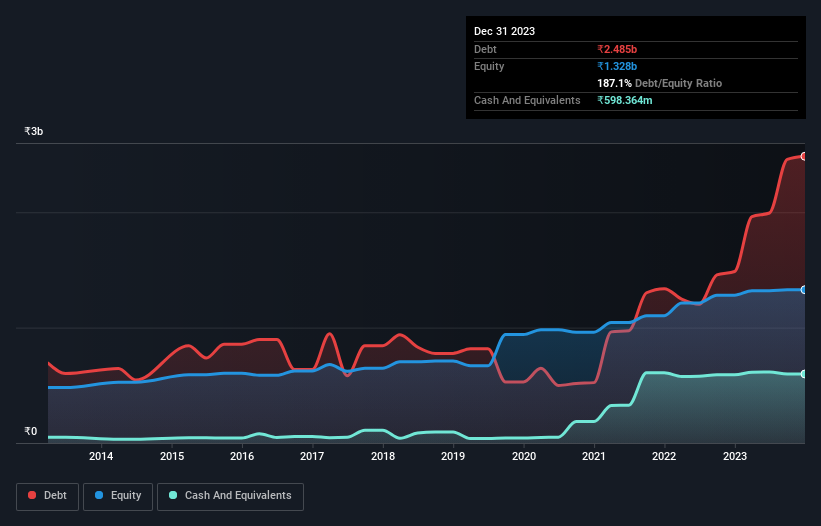These 4 Measures Indicate That Reliance Chemotex Industries (NSE:RELCHEMQ) Is Using Debt In A Risky Way

Warren Buffett famously said, 'Volatility is far from synonymous with risk.' When we think about how risky a company is, we always like to look at its use of debt, since debt overload can lead to ruin. Importantly, Reliance Chemotex Industries Limited (NSE:RELCHEMQ) does carry debt. But is this debt a concern to shareholders?
Why Does Debt Bring Risk?
Generally speaking, debt only becomes a real problem when a company can't easily pay it off, either by raising capital or with its own cash flow. Part and parcel of capitalism is the process of 'creative destruction' where failed businesses are mercilessly liquidated by their bankers. However, a more usual (but still expensive) situation is where a company must dilute shareholders at a cheap share price simply to get debt under control. Having said that, the most common situation is where a company manages its debt reasonably well - and to its own advantage. When we think about a company's use of debt, we first look at cash and debt together.
See our latest analysis for Reliance Chemotex Industries
What Is Reliance Chemotex Industries's Debt?
You can click the graphic below for the historical numbers, but it shows that as of September 2023 Reliance Chemotex Industries had ₹2.49b of debt, an increase on ₹1.49b, over one year. However, it does have ₹598.4m in cash offsetting this, leading to net debt of about ₹1.89b.

A Look At Reliance Chemotex Industries' Liabilities
Zooming in on the latest balance sheet data, we can see that Reliance Chemotex Industries had liabilities of ₹1.62b due within 12 months and liabilities of ₹1.58b due beyond that. On the other hand, it had cash of ₹598.4m and ₹90.5m worth of receivables due within a year. So its liabilities total ₹2.50b more than the combination of its cash and short-term receivables.
The deficiency here weighs heavily on the ₹1.60b company itself, as if a child were struggling under the weight of an enormous back-pack full of books, his sports gear, and a trumpet. So we definitely think shareholders need to watch this one closely. After all, Reliance Chemotex Industries would likely require a major re-capitalisation if it had to pay its creditors today.
We measure a company's debt load relative to its earnings power by looking at its net debt divided by its earnings before interest, tax, depreciation, and amortization (EBITDA) and by calculating how easily its earnings before interest and tax (EBIT) cover its interest expense (interest cover). This way, we consider both the absolute quantum of the debt, as well as the interest rates paid on it.
Weak interest cover of 2.2 times and a disturbingly high net debt to EBITDA ratio of 5.9 hit our confidence in Reliance Chemotex Industries like a one-two punch to the gut. The debt burden here is substantial. Worse, Reliance Chemotex Industries's EBIT was down 29% over the last year. If earnings continue to follow that trajectory, paying off that debt load will be harder than convincing us to run a marathon in the rain. When analysing debt levels, the balance sheet is the obvious place to start. But you can't view debt in total isolation; since Reliance Chemotex Industries will need earnings to service that debt. So when considering debt, it's definitely worth looking at the earnings trend. Click here for an interactive snapshot.
Finally, a company can only pay off debt with cold hard cash, not accounting profits. So the logical step is to look at the proportion of that EBIT that is matched by actual free cash flow. Over the last three years, Reliance Chemotex Industries saw substantial negative free cash flow, in total. While investors are no doubt expecting a reversal of that situation in due course, it clearly does mean its use of debt is more risky.
Our View
To be frank both Reliance Chemotex Industries's conversion of EBIT to free cash flow and its track record of (not) growing its EBIT make us rather uncomfortable with its debt levels. And even its level of total liabilities fails to inspire much confidence. It looks to us like Reliance Chemotex Industries carries a significant balance sheet burden. If you play with fire you risk getting burnt, so we'd probably give this stock a wide berth. When analysing debt levels, the balance sheet is the obvious place to start. However, not all investment risk resides within the balance sheet - far from it. Be aware that Reliance Chemotex Industries is showing 6 warning signs in our investment analysis , and 1 of those can't be ignored...
Of course, if you're the type of investor who prefers buying stocks without the burden of debt, then don't hesitate to discover our exclusive list of net cash growth stocks, today.
New: AI Stock Screener & Alerts
Our new AI Stock Screener scans the market every day to uncover opportunities.
• Dividend Powerhouses (3%+ Yield)
• Undervalued Small Caps with Insider Buying
• High growth Tech and AI Companies
Or build your own from over 50 metrics.
Have feedback on this article? Concerned about the content? Get in touch with us directly. Alternatively, email editorial-team (at) simplywallst.com.
This article by Simply Wall St is general in nature. We provide commentary based on historical data and analyst forecasts only using an unbiased methodology and our articles are not intended to be financial advice. It does not constitute a recommendation to buy or sell any stock, and does not take account of your objectives, or your financial situation. We aim to bring you long-term focused analysis driven by fundamental data. Note that our analysis may not factor in the latest price-sensitive company announcements or qualitative material. Simply Wall St has no position in any stocks mentioned.
About NSEI:RELCHEMQ
Reliance Chemotex Industries
Engages in the manufacture and sale of synthetic and blended yarns in India.
Moderate unattractive dividend payer.
Market Insights
Community Narratives




